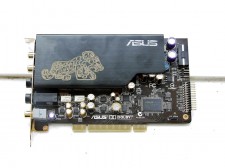
Sound cards: an industry that has long been dominated by the likes of Creative; with their Sound Blaster series of add-on devices. One could say that using the aforementioned company products is a mixed bag as they blessed us with decent voice synthesis to replace the old Adlib cards. Since then Creative has dominated the market with a slowly increasing line of products. However the other side of the coin is that a rising company back in 1992 (around the time when Doom was launched) going by the name of ‘Advanced Gravis’- released the Ultrasound range of cards (or GUS was its friendly moniker) they for a short while gave Creative a run for their money; with its first generation wave table cards, programmable musical instruments etc. However the world was hooked like sheep onto the Sound Blaster name and despite having a big name in the music world and being technically superior in every way, the advanced Gravis Ultrasound died a lonely death! This reviewer remembers this sound card with great fondness.
Recently Creative has courted controversy by deliberately disabling certain features in their drivers so as to cause complications in Windows Vista. This was done in order to force owners to purchase their Alchemy software which re-enabled those same features again. A gentleman known as Daniel_k discovered this issue and re-enabled the features again, by the use of a software hack. Creative then threatened to prosecute the aforementioned gentleman; however this all back-fired when Daniel reported this to the press and instantly Creative shares dropped by seven percent overnight. Anyone whom uses Creative sound cards will freely recognize the bloatware drivers and the issue of the aforementioned drivers causing a slower boot up time.
Today Overclockers Tech can possibly offer the consumer an alternative by Asus, namely the Xonar Essence ST! Billed as a musicians sound card first and a gamers card second, one can not help but be thrown back to the year 1992 and the era of the Advanced Gravis Ultrasound!
A 1992 Throwback
The year 1992 brought us many things; we had the first female black astronaut (Dr. Mae C. Jemison), Windsor Castle caught fire, Rodney King met a few ‘nice’ policemen; prompting the LA riots and finally a well known Rap artist by the name of ICE-T released the Cop Killer single to great controversy. However in the computer world there were two major stories that were exploding around the world. The Gravis Ultrasound card and a new product from an unknown company called id Software with the game that was entitled Doom!
Though this review is for the Asus Xonar Essence card and is billed as a musician’s sound card, Overclockers Tech wishes to take you back to the above year in order to help the reader to understand the strategy employed by Asus!
Whilst Creative was enjoying its well deserved monopoly on the sound card market, a company from Canada, best known for its joysticks and game pads released the Ultrasound to critical acclaim. Whilst Creative were still releasing new cards, there was little difference between them; being based upon tweaks of an existing design. All of a sudden Advanced Gravis came into play and turned this thinking upside down. This product was the first to use wave table synthesis, a system based upon actual REAL instruments rather than that of sound card generated ones, programmable instruments (in other words if one did not like the standard instruments available, you could record and use your own) and finally, to allow for those features Gravis’s innovated on board RAM! Creative unleashed the AWE32 to combat this, and whilst it did capture the gamers minds, the musicians gave the Ultrasound a place of their own!
| Year Released 1992 | 1994 |
Despite the groundbreaking features, the Gravis’s unique sample-RAM architecture proved too much for the industry. Some game developers of the time noted problems with the software development kit and the product’s hardware design. On the user-side, the Sound Blaster emulation was especially hard to get right out of the box, and this resulted in a substantially high number of product returns at the store level, and thus soured the retail channel on the product. Bundled software was refined over time, but Gravis could not distribute updates effectively. However, if we now move onto the present, we no longer use MS-DOS and we are GUI based, so in essence there is no need to emulate a Sound Blaster in any game.
Back to the present and Company Background
ASUS comes from the last four letters of Pegasus, the winged horse in Greek mythology that represents the inspiration of art and learning. ASUS embodies the strength, creative spirit and purity symbolized by this regal and agile mythical creature, soaring to new heights of quality and innovation with each product it introduces to the market.
Asus was formed in 1989 by four engineers whom wanted to do things a little different from anyone else. Since then if one were to say that Asus was popular, then it would be a gross understatement. It would be akin to saying that Tony Blair is ever so slightly craven, when infact he is missing a spine!
The company is well known for producing high quality motherboards and graphics cards (Asus Mars) it is with high hopes that the Xonar Essence can continue this tradition.
Boasting a long list of specifications, it is hoped that this sound card can perform up to the standard that various rumours over the Internet claim. Love or hate them, one must acknowledge that Creative Labs have monopolized the add-on sound card market. It would be interesting to see if Asus can indeed offer a viable alternative to Creative Sound Blaster range of sound cards.
An impressive number of specifications, one is sure the reader will agree; however let us move on to the packaging and see what the ‘fuss’ about this sound card is all about.
Product Packaging
The dark packaging is loaded with an impressive amount of numbers and slogans to keep your eyes moving to the next piece of information. The top lid, gives just enough of a preview to make the consumer want to rip open that box to get at the product, rather like a child at Christmas. So let us look at what Asus has given us in the way of a sound card.
The following is taken directly from the Asus website : “Thousands of years ago, our ancestors crystallized their knowledge of the materials and music into the Chime of Tiger, one of the first audio masterpiece in human history. Gold-plated on the EMI shield, the Chime of Tiger totem not only represents Xonar teams new footnote in audio innovation, but also mankind’s endless pursuit of the Essence of Sound.”
The inner accessory tray though plain, is well presented. One feels that given the contents of this box, the packaging on this section could have been a little thinner, thus saving money.
Box Contents:
- ASUS Xonar Essence STX 2 Channel PCI-E X1 Audio Card
- RCA to 3.5 mm Y Cable
- 6.3mm to 3.5mm Adapter
- S/PDIF TOSLINK Optical Adapter
- Driver CD
- Quick Start Guide
- Audio Precision Test Report
- Two Posters
All in all a well presented bundle. The packaging is very well thought out and indeed the box logo has been designed to grab consumers attention without making the whole product seem ‘ loud’.
The Xonar Essence ST Card Itself
The inner plastic carton holds the product, however the molding of the carton looks to be a little ‘tight’ as when the box was opened one of the pins on the card was ever so slightly bent. Asus needs to look into this.
At first glance the Xonar Essence has a resemblance to any other sound card, however this is a first glance only! After closer inspection we find many things that differ from a whole host of other sound cards clambering for the consumers attention. The most obvious difference being the analog output circuitry, it is shielded by a grounded metal cover. This cover is anodized black with a stylized image of a Chinese tiger printed in gold. The cover acts as a Faraday shield, preventing interference from contaminating the analog signals.
As one can see though the shield will do its job, the finish on the shield itself is a finger print ‘magnet’, however once the card is inside the case this will not be shown at all.
On the card’s exterior is a vertical array of jacks. From top to bottom, on the two gold-plated RCAs are the right and left analog line outputs, followed by the headphone output on a 6.3mm stereo phono jack. Below that, another 6.3mm stereo jack serves as both the line and microphone inputs, this can be selected by the use of the Xonar Software interface. Lastly is a RCA jack that provides a standard S/PDIF digital output capable of running at sample rates up to 192kHz.
With the above being mentioned one can already assume that this product is built for audiophiles in mind. It is with hopes that the product can actually slot into this role and not simply be relegated to the position of a ‘gamers card’ like so many products out there!
What is also noticeable is the gold capacitors placed all along the card and a great many placed around the headphone amplifier chip, it is good to see that Asus has indeed listened to what ‘Audiophiles’ have to say and implemented this in the design of the product.
One of the more interesting features of the Xonar Essence ST is the Texas Instruments 6120A2 headphone amplifier chip capable amplifier chip for headphones and can handle impedance up to 600 ohms! This chip is the basis of some standalone high-end headphone amplifiers.
The AV100 is the same C-Media OxygenHD (CMI8788) sound processor used on the rest of the Xonar line and on HDA/Bluegears/Auzentech cards. It provides a mixture of hardware and software support for DirectSound/DirectSound3D, OpenAL, and A3D.
It is interesting to note that Asus have chosen to implement a four-pin molex connector at the back of the card in order to power the headphone amplifier and to provide a cleaner signal to the capacitors, as the power from the PCI socket is not up to the task. One cannot see that the card should need the extra power for better sound, however for the headphone amplifier this would make sense!
Subjective Testing: Music
Before we explore the Xonar Essence ST any further it must be noted that from this point onward the review becomes subjective in nature, and so this reviewer will do his best to describe the quality of the sound issued from the card.
Test Equipment
-
Kenwood home cinema Amplifier (set to BYPASS so the sound card does all the processing and not the amplifer; except that of amplification)
- Eltax Concept 180 floor mounted speakers
- Cambridge Audio Ultra 100 speaker cable
- Cambridge Audio AUD3000 1M phono inter connectors between sound card and the amplifier
-
Spare sound cards for comparison, which include Audigy 2 ZS and the XFI-Extreme Music (Daniel K drivers)
In this review we could have tested the sound quality using a regular Compact Disk Album. However this reviewer had the philosophy that if a consumer is playing music on their computer then the chances are they would be using MP3’s.
This reviewer has an ecclectic taste in music, so testing was performed using a wide range of music from Mike Oldfield and Kate Bush to Hip Hop and Heavy metal.
For testing in the music section, the settings used where “Two Speaker” and “Hifi”‘ as this disables any virtual 7.1 sound and the equalizer thus given a crisp clean sound!
Software Settings in this mode
Kate Bush Wuthering Heights (New Version)
Sound Blaster (ZS and X-Fi) The piano at the start of the track was not convincing and sounded slightly muffled. Though the lyrics sounded very clear. Though both sound cards did well at chorus section producing a solid bass sound.
Asus Xonar Essence ST: The piano notes at the start were faultless and was very uplifting as a real piano would be. The transition between the notes and the start of the lyrics was a pleasure to hear. This was coupled with a solid clean bass at the chorus section.
Mike Oldfield Tuberlar Bells Two (The Bell)
In this track there are a range of twenty differing instruments played all at once; so this would be the ultimate test as far as playing music of this type.
Sound Blaster (ZS and X-Fi) The tuber bells instrument and the acoustic guitar sounded very well rendered, in addition to the french horn, but once again the grand piano failed to be ‘grand”. However, overall the bass notes where correct and the track was a rather enjoyable experience.
Asus Xonar Essence ST: The acoustic guitar and the grand piano is where this sound card really shined, almost giving a ‘live experience’, the tuberbells instrument was on par with the X-FI Extreme Music and the bass once again stood out.
1980’s Music: Human League (Love Action)
Whilst being on the ‘cheesy’ side, this track is still known today for its great bass and rhythm.
Sound Blaster (ZS and X-Fi) A real solid thumping sound that had this reviewers head bobbing along to the music and twenty years later this track still makes people want to dance.
Asus Xonar Essence ST:A brilliant solid track once again easily on a par with soundblaster cards but with a slightly better analogue synth sound.
Hop Hop ICE-T Leathal Weapon (From the Album Iceberg)
A great track and brilliant samples taken from Eric B and Rakim’s ‘Microphone Fiend’ song. Subtle electric guitars and a high level of turn-table use.
Sound Blaster (ZS and X-FI) A thoroughly brilliant performance from both of the sound blaster cards with its solid bass and the ‘scratch’ sounds issued by the turn table’ However the guitars did sound a little muted, even given that they are more subtle in this track.
Asus Xonar Essence ST: Another thoroughly enjoyable performance with a solid bass, great guitar work.
Hijack: Style Wars
One of the most well remembered tracks of early UK-Hip Hop that broke the mold, competing with the likes of Overlord X, Derek B and MC Duke. This track features fast vocals and an almost legendary use of the turntables.
Sound Blaster (ZS and X-FI) High distinct ‘scratch’ sounds, but slightly ‘blurred ‘ vocals, however still an enjoyable experience!
Asus Xonar Essence ST: Crystal clear vocals and the best bass this reviewer has heard of yet!
Operatic Metal
Sirenia: The Path to Decay and the Mind Maelstrom
Operatic Metal combines heavy guitars with extremely strong vocal talents, including that of the ‘growler’ and the opera vocals.
Sound Blaster (ZS and X-Fi) High vocals are not very distinctive in addition to the guitars, with both blurring into one another, however the bass was exceptional.
Asus Xonar Essence ST: Brilliant distinctive operatic vocals and the guitars sounds were really accented in this track. As usual the bass was excellent.
Industrial Metal
Sonne
Almost everyone has heard of Rammstien, having featured on many films. Their songs feature guttural angry vocals (due to the German accent) and extremely heavy guitars often eclipsed by some almost operatic vocals.
A dark track that features more on the vocal side than guitars.
Sound Blaster (ZS and X-Fi) Vocals a little ‘hissy’ on the operatic section, however a solid bass produced.
Asus Xonar Essence ST: Clear operatic vocals, bass on par with the Creative sound cards.
Rammstien:Du Hast
A Rammstien track that combines heavy electric guitars to an almost heavy thumping dance beat.
Sound Blaster (ZS and X-FI) A solid bass line however the guitars though sounded good were not distinct.
Asus Xonar Essence ST: Once again a solid bass line, however the guitars really stood out in this track.
Doom Metal
Paradise Lost have been credited with the formation of the genre ‘Doom Metal’. Having been around for twenty years they have experimented from early ‘growly’ metal to an almost depeche mode type sound and then metal again.
In Requiem
Famous for its guitar solo at the start and at the closing sections, this will test the sound cards ability to render the instruments correctly. This would be the ultimate test for guitar solo sound quality.
Sound Blaster (ZS and X-Fi) The guitar, though well rendered, sounded a little artificial. When the rest of the guitars (particularly the bass) joined in the tune played well.
Asus Xonar Essence ST: The lone electric guitar at the beginning was so well rendered that it sent shivers down this reviewers spine! Just as this reviewer was getting used to that, the other guitars kicked in and the whole track sounded flawless
Paradise Lost. The Enemy
If there was a metal song that was meant to be performed ‘live’ then this is it. Strong vocal clarity is a must here
Sound Blaster (ZS and X-Fi) Great performance in this song, but still a very slight hiss in the vocal sections, as usual great bass and good guitar sounds
Asus Xonar Essence ST: Vocals were crisp with no trace of a hiss, complete with a thumping guitar
To be fair if we reviewed the Creative cards on their own, as far as sound quality are concerned they would achieve a silver award! However when in comparison to the Asus Xonar Essence ST that score would indeed fall. The sound quality difference in terms of music is like night and day, this reviewer means to say that the difference is not subtle at all it is rather like a slap in the face by a rather large whet fish!
Subjective Tests: Movies and Games
In all honesty this test has been performed as almost an after thought. If a consumer purchases a sound card of this quality, they usually do not want to use it for games or home cinema, they want it to play their CD/MP3 Collection.
Movie Mode Settings
All movies where set to 7.1 virtual speakers, this is where the software tries to emulate a home cinema environment by using only two speakers. Power DVD software was employed in order to play back the DVD’s, and a single DVD titled was used, James Camrons’ The Abyss’ the Directors cut.
Sound Blaster (ZS and X-Fi) This is where Creative comes into its own, whilst the sound quality was on a par with other sound cards the holographic sound (virtual 7.1 speakers) was nothing short of amazing, considering there were only two speakers!
Asus Xonar Essence ST: Whilst the actual audio quality sounded better than the Creative sound card, by a long margin, the virtual 7.1 sound was not anywhere near as convincing as the Soundblaster cards tested.
Game Mode Settings
Whilst clearly the Asus card is not engineered for a gaming environment, it is thought we should review this section anyway. Testing was undergone by installing a popular game known as ‘Oblivion’ using the same environmental sound (stone corridor) as utilized by both cards, EAX on the Creative cards and DS3D GX on the Asus.
Sound Blaster (ZS and X-Fi) The creative cards did an amazing job, with footfalls in the stone corridor being rendered perfectly in crisp quality sound, giving a great sense of atmosphere!
Asus Xonar Essence ST: Whilst the gaming audio quality was every bit as good as the Creative cards, this reviewer did feel that the Stone Corridor emulation was not quite as convincing the Sound Blaster cards. The footfalls being interesting but not to the degree used by the Creative products.
Conclusion
Whilst we have only briefly touched upon the driver and software interface of the sound card, it is worth noting the file size of the Asus drivers and Software totals only around ten megabytes. The software being stable as a rock, which surprised this reviewer a great deal. The only draw back being that the Windows 7 drivers are not on the install disk and must be downloaded. Additionally Asus could have bundled some freeware Audio utilities with their product, such as MP3 Tag renaming or MP3/audio clean up software!
Having listened to the sheer sound quality of this card one cannot help but be profoundly amazed. The sound rendering simply wipes the floor (as far as music is concerned) with anything a Creative card can do. With the Farady shield in place against Electro-Magnetic interfearence and the attention to detail as far as the board layout and components are concerned, this is what one would expect of a semi-professional card. When one compares directly with the Creative and the Asus Xonar Essence ST together, then as previously stated the comparision is not subtle! Once again, using a previously coined phrase the sound quality difference is about as subtle as slap across the face with a whet kipper!
Granted the Creative cards have better virtual sound in addition to the environmental sounds used for games, however if its the best sound quality and the best quality in music your after then one would be a fool to turn down the Asus card. Back in the days of MS-DOS one needed a Creative card for driver compatibility. However those days are long gone and a Creative card is not essential in the days of a Windows based system. Like the Gravis Ultrasound of old, the Asus Xonar Essence simply wipes the floor with the Creative products, in terms of music. If it is games that a user requires a sound card for, then either look at the Creative Line of cards or the Asus Xonar D2 range. Like an old pair of shoes people are comfortable with Creative cards, but those shoes are starting to be worn out now, by the lack of innovation and the Daniel_K fiasco that people still remember to this day. For music there is none better than the Asus Xonar Essence ST! Its stable drivers, its wonderful compatibility with Windows 7 is a boon to all music lovers everywhere!
On a final note, after testing many audio cards through out this reviewers computing life , this writer has come to the conclusion that most sound cards either produce a great bass or an clear treble, but nothing inbetween. The Xonar Essence ST excells at all these frequences that these instruments belong, and for its time there where was only one other sound card that managed this feat and that was the Ultrasound Max. As an ex Gravis Ultrasound fanatic, one feels that this reviewer has found a new home in the Asus Xonar Essence ST, the thinking-mans sound card!
Pros:
-
Sound Quality is simply amazing
-
Good quality components
-
Nice Idea on the Farady shield
-
Phono Connectors
-
In built Head phone amplifier
-
Stable Drivers
-
Software Interface is easy to use
- Did we say crisp clean sound? Well yes we did but it is so good we thought we should mention it again
- Cons:
-
Lack of any bundled Software, even freeware
-
Enviromental Sounds in games are not as convincing as the Creative products.
Overclockers Tech is pleased to announce a thoroughly deserved score of 9.5/10, this is based on the sound quality and the unique nature of the Faraday shield. The Asus Xonar essence has therefore achieved our highest award, a gold medal.
Author: Gilgamesh



















































 Posted in
Posted in 

